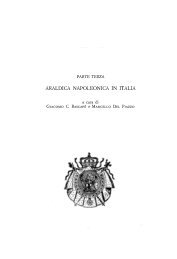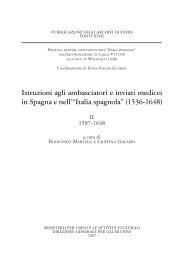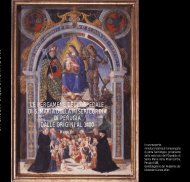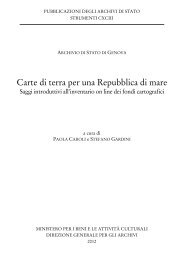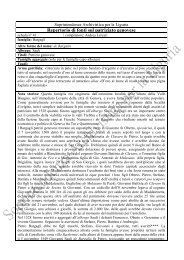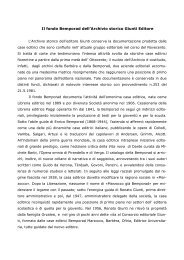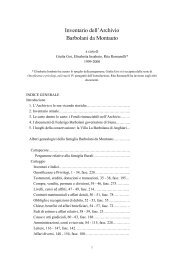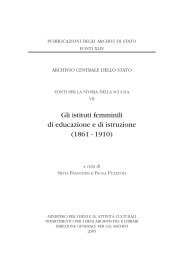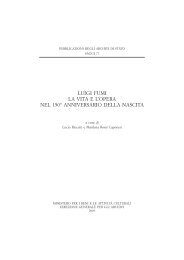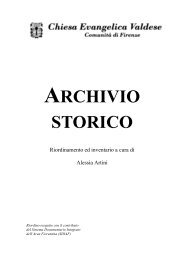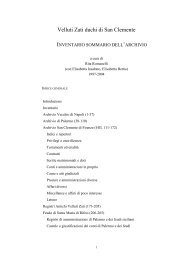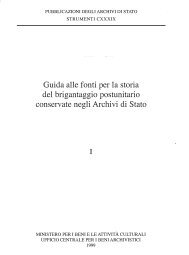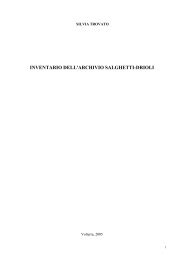ITALIA JUDAICA. Atti del I Convegno internazionale. Bari 18-22 ...
ITALIA JUDAICA. Atti del I Convegno internazionale. Bari 18-22 ...
ITALIA JUDAICA. Atti del I Convegno internazionale. Bari 18-22 ...
Create successful ePaper yourself
Turn your PDF publications into a flip-book with our unique Google optimized e-Paper software.
no early loeaI figure who is a counterpart or counterweight to Rashi or R. Isaac<br />
AHasi, in the sense of being intrinsically important as \Veli as representative.<br />
Italy is alternately centrifugaI and centripetal but lacking internaI cohesiveness<br />
and continuity. No\v, to be sure, the towering figure R. Isaiah of Trani, for<br />
example, does quote R. Natan of Rome, R. Solomon ben ha-Yatom, R. Isaac<br />
ben Malkizedek, and R. Barukh ben Samuel of Aleppo (and in one respolZsum<br />
cites also R. Hillel ben Eliaim of Greece) 17, as he himself is quoted frequently<br />
by R. Zedekiah b. Abrabam in the Shibbolei ha-Leqet; this is noteworthy and<br />
as such suggests a chain of tradition, but it is also rare and hence does not con<br />
stitute nativism or regionalism.<strong>18</strong> There is no evidence that he sees himself<br />
as part of an accumulative, accretionary Itdian enterprise, endowed with spe<br />
eial features, methods, traditions, loyalties, assumptions or inclinations. R.<br />
Isaiah is clearly basing himself on R. I;!anan'el and Rif, on one hand, and Rashi<br />
(the teacher par excellence) and the Tosafists on the other; he is more Ashke<br />
IZazi than Italian and perhaps should be classified as a Tosafist (even though<br />
Prof. Drbach in the Ba'olei ha-Tosa/or has included his colleague R. Eli'ezer b.<br />
Samuel of Verona, a student of Ri, as an Italian Tosafist while excluding R.<br />
Isaiah himself, a student of R. Simllah of Speier). Maimonides, we may note,<br />
does not appear too frequently on the pages of R. Isaiah. For him, in any event,<br />
the entire halakhic enterprise is unified, transcending geographic boundaries ;<br />
wide-ranging selectivity is perfectly appropriate and discriminating edecticism<br />
is a virtue in rabbinic writing.<br />
We may note pointedly by way of anticipation - and tbis needs to be<br />
fully elaborated - that this remains the regnant attitude and reality in the fif<br />
teenth and sixteenth centuries, a period of Italian efflorescence and intensive<br />
creativity. There are French, German, Spanish and Levantine influences.<br />
CentraI and northern Italy are dotted with bustling, thriving centers in close<br />
contac with Ottoman and East European Jewish commuruties. Rapidly shif<br />
ting geographic, demographic, ethnic, political, communal and cultural factors<br />
militate against the crystallization of any nativism in such prominent figures<br />
as R. Joseph KoIon, R. Jacob Landau CAgur), R. David Messer Leon, R. 'Az<br />
ri'el Dienna, R. Joshua Boaz (Shiltei Gibborim, in wbich, as is known, the<br />
writings oE R. Isaiah the Younger are preserved), R. Me'ir of Padua, R. 'Azariah<br />
Figa, R. Abraham Portaleone and many others on to R. Isaac Lampronti (Pahad<br />
Yitzaq). This ethnic-haIakhic heterogeneity, of course, contrasts sharp<br />
Iy with the sturdy, sometimes aggressive, Ashkenazi sentiment and allegiance<br />
which characterize centraI and Eastern Europe at this time, where Ashkenazi<br />
origins are flaunted (ll::>lVN 'NllNll 'lN) and the normativeness of Ashkenazi<br />
precedent is held aloEt.<br />
390<br />
Even in the early period, the relative paucity of Ashkenazi rabbinic li-<br />
17 Teshuvo[ ha-Rid, 34.<br />
1 8 The Ashkenazic element is predominant in the Shibbolei ha-Leqet.<br />
terature from the tenth and eleventh centuries notwithstanding, asidei Ashkenaz<br />
of the twelfth and thirteenth centuries happily Iooked upon themselves<br />
as heirs of the earlier Ashkenazic tradition.<br />
As far as I am able to establish, there is at no time Italian resistance<br />
to Ashkenazi expansion and entrenchment or to cny other kind of intrusion.<br />
Ashkenazi views are welcomed, recognized as indispensabIej witness the cases<br />
of R. Isaiah and his predecessors. We may note in addition, for example,<br />
that at a later period R. Jol;anan Alemanno's projected curriculum" lists R.<br />
Isaac Alfasi, R. Isaiah the Younger of Trani and R. Asher ben Yel;i' el as the<br />
three authoritative codiliers - and the first and the third appeal' (together with<br />
Maimanides) in R. Joseph Karo's triumvirate oE authorities. This lack 01<br />
resistance contrasts sharpIy and symbolically with events and attitudes in thir<br />
teenth century Provence - ha-Me'iri's time and piace. Toward the end of the<br />
century Spanish students of Nal;manides were imperiousIy trying to impose<br />
their customs and teaching on the Provençal communities. The Provençal lea<br />
ders reacted to this pretention to superiority with pride and determination,<br />
with awareness of the antiquity, distinction and distinctiveness of their own<br />
traditions. Their spokesman was R. Menal].em ha-Me'iri, whose Magen 'Avo! is<br />
an eloquent defense of Provençal tradition and hence a barricade against Spanish<br />
halakhic imperialism. Italy has apen borders. The Shibbolei ha-Lefo,e!<br />
1s the greatest repository of the early teachings of Ashkenaz. There is no<br />
Italian Magen ' Avot20<br />
In sum, R. Menal).em ha-Me'iri's judrnent - and this is implicitly shared<br />
by R. Moses af Coucy (Se/er Mizvo{ Gadol) before him and R. Menal;em ben<br />
Zeral; (Zedah la-Derekh) or R. Jacob Landau CAgur) after him in the historical<br />
prefaces to their codes - is as follows : while the beginnings of rabbinic culture<br />
in Europe are shrouded in the silence, often obscurity, of oraI learning,<br />
there comes a point when we are able to discern dear features of continuous<br />
literaty creativity, consciousness of writing for anci influencing the entire nation,<br />
and transmission and steady-sturdy patterns of study and writing. Italy - SidIy<br />
(whether Muslim [until 1061] or Norman), the Byzantine southern region,<br />
the papal states in the center, and the north under Lambard, Carolingian, Saxo<br />
nian, or Ottoman rule - was an exception. He, therefore limits his review to<br />
northern Europe, southern France, and Spain.<br />
If we now forget ha-Me'iri and the historically significant medieval self<br />
image and undertake to review this issue dispassionately, we would note<br />
the dramatic developments in western Europe from about 1050 to 1200 - a<br />
reai rabbinic renaissance : Rashi and the most creative generations of Tosafists;<br />
R. Jonathan ha-Kohen, Rabad, R. Zerahyah ha-Levi, R. Meshullam, R. Moses<br />
J9 See M. IDEL, Seder ha-Limmud shel R. Jo!;anan Alemanno, in Tarbiz, XLVIII (1979),<br />
p. 304. B. Septimus notes that Luzzatto'-s Ma'amar has no Italian «heroes ».<br />
20 Even though it should be noted that the T anya Rabbati is described as sefe!' minhag<br />
'avo[; see n. 14 above.<br />
391



